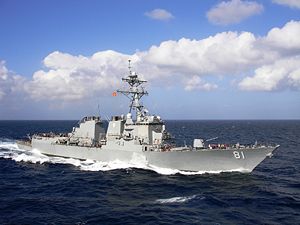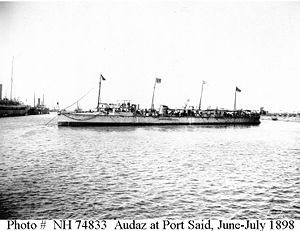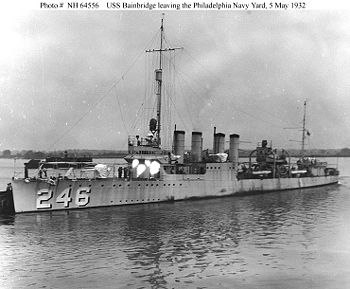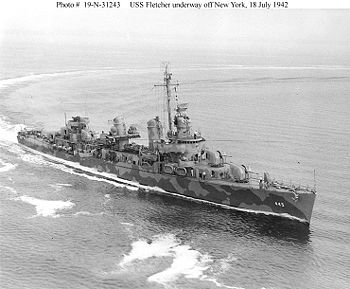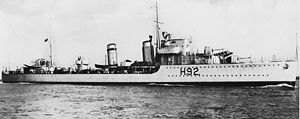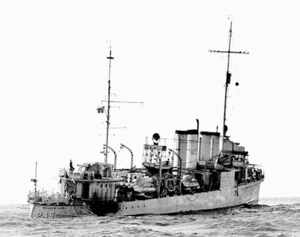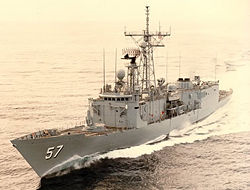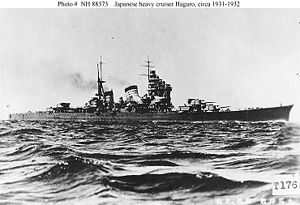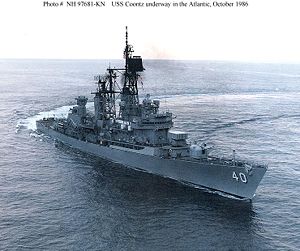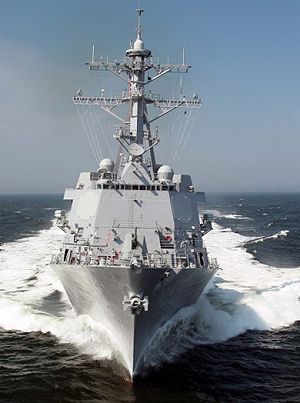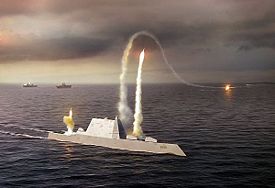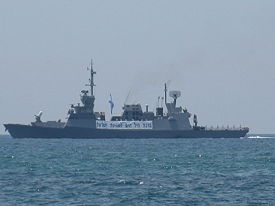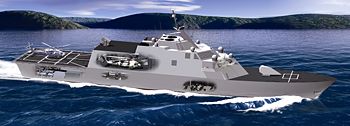Destroyer
- See also: Cruiser
- See also: Ocean escort
- See also: Fast attack craft
A destroyer is a type of warship, the nature of which has evolved since it first came into use, roughly at the beginning of the twentieth century. Several other warship designations have, at different times and in different navies, overlapped the "destroyer" role. Most common among these roles are cruiser and ocean escort. Another type of vessel, whose nomenclature is the root of "destroyer", has been called "torpedo boat" and exists in new forms generically called fast attack craft.
Initial usage
When the modern self-propelled torpedo was invented, in 1866, by Robert Whitehead, it was initially added to conventional warships, but navies soon realized that a small, fast craft, with a main battery of torpedoes, could threaten much larger warships such as battleships. The battleship of the early 20th century was the largest, most heavily armed, and most heavily protected warship type, but relatively slow and not extremely maneuverable. Torpedo boats were generally not capable of long-range steaming or being seaworthy in the "blue water" deep ocean; they were coastal craft.
When battleships and other large ships, possibly escorting unarmed cargo and troop transports, needed to approach a hostile shore, they needed to deal with the torpedo boat threat. A partial solution was adding a secondary gun battery of smaller caliber, faster firing rate, and faster aiming than the main guns intended to sink other battleships, but the secondary battery still let the torpedo boats come too close.
A new type of vessel, called the torpedo boat destroyer, was developed as an escort to major warships, and possibly merchant vessels threatened by torpedo boats. In the words of a requirement restated a century later, "Self-deployability (blue water endurance) is needed to allow the platforms to get to the contested area without the need for valuable and scarce open ocean transport or the support of an ever-present mothership." [1] Such vessels still had to be small, fast, and maneuverable enough to pursue and destroy torpedo boats. Early approaches to increasing range and self-deployability included the use of sails in addition to steam, on the Spanish torpedo boat destroyer Audaz, in service between 1897 and 1927.
It soon became obvious that the torpedo boat destroyer was a useful vessel for a wide range of applications, such as convoy escort, so the specialized designation became the simple destroyer. Ironically, while the first destroyers were armed only with quick-firing guns, usually of several calibers from medium to light, navies started equipping destroyers with torpedoes, as the weapon of choice if they did need to confront battleships. For simplicity, the category of "cruiser" is not being included in this immediate discussion; simply assume they were vessels of intermediate characteristics between battleships and destroyers.
The new destroyers would usually make torpedo attacks in groups. Such groups would often be built around a light cruiser or a ship called a destroyer leader; both types were more survivable and more heavily armed than destroyers, which better fitted them to lead the attack unit. Early destroyers were intended to be small and inexpensive, with numbers of hulls being more important than individual ship capability.
First World War, and a new torpedo threat
The pure torpedo boat was becoming less popular around the start of the First World War, although variants would keep returning. Torpedoes, however, were still a real threat, but from submarines rather than surface vessels.
Technology for finding submerged submarines lagged the introduction of the undersea weapons, and was quite primitive and short-ranged. In general, the first antisubmarine sensors were passive listening devices, called hydrophones. Putting hydrophones on many destroyers allowed an antisubmarine screen to be formed around the "high-value assets", the vessels the submarines had as primary targets.
Once a submerged submarine was located, location being a very loose term at the time, the destroyer needed some way to attack it. Clearly, guns that could blow a surface torpedo boat out of the water were not the answer, since they cannot shoot at underwater targets. The first antisubmarine weapons were depth charges, or containers of explosives that would be dropped, from the surface, over the location of a suspected submarine, and would detonate when they reached a preset depth. The submarine's depth was even harder to determine than its range and bearing from the destroyer; it was estimated based on the strength of the sound, knowledge of the bottom depth and water characteristics, and a seaman's judgment. Since the submarine's position was poorly defined, large explosive charges were needed to have a chance of damage with other than a lucky direct hit.
By 1918, however, an active sound-based technique, code-named ASDIC for an apparently nonexistent "Allied Submarine Detection Investigation Committee" was mounted on several British and U.S. destroyers. It came too late for combat use in the First World War, but development actively continued. The more common term became sonar, for "sound detection and ranging". In modern intelligence terminology, active and passive sound-based systems were the acoustic MASINT or acoustic intelligence of geophysical measurement and signal intelligence.
Torpedoes, and things that carry them
By the Second World War, aircraft could drop torpedoes, as well as use weapons including machine guns and bombs. In its evolving role as an escort, as well as being a general-purpose craft for independent assignments, the destroyer now needed to add anti-air warfare to its anti-submarine warfare and anti-surface warfare roles.
Often, the generic radio call sign for U.S. destroyers was "small boys". Indeed, destroyers were small beside the aircraft carriers and the impressive but obsolete battleships. Arleigh Burke, a noted destroyer unit leader in WWII, is, ironically, the namesake for today's Burke-class destroyers. When a Burke-class vessel can shoot cruise missiles at land targets 1000 miles away, fire surface-to-air missiles at aircraft 100 miles away (and tracked farther away), and even may "shoot a bullet with a bullet" in ballistic missile defense, the small boys have grown up.[2] There are, however, emerging new warship types that may be the "small boys" of tomorrow, such as the Littoral Combat Ship. With today's navies, however, their crews will include not-so-small girls.
Antisubmarine evolution
Destroyers now were the primary antisubmarine warfare weapons, with active sonar as their primary sensor, supplemented with passive listening, and radar detection of surfaced submatines. Particularly in the Battle of the Atlantic, submarine hunting also had the benefit of national-level intelligence information, including signals intelligence from German fleet headquarters to submarine radio, including direction finders aboard warships. Very long range patrol aircraft also could spot submarines.
The depth charge was still the primary antisubmarine weapon, although more flexible launchers were developed. Previously, they were rolled off a rack at the stern, but devices such as "K-guns" allowed the depth charges to be thrown to the sides of the destroyer, allowing circular patterns to be dropped. Depth charges had the disadvantage of creating great disturbance in the water after they exploded, making sonar useless until the water calmed, and possibly letting the submarine escape in the noise.
"Hedgehog" used a very different method, of a number of small charges launched straight ahead of the submarine, which made the approach to the target more intuitive."...if they used a missile that only exploded if it hit the target, they could afford to cut down the weight very significantly." Hedgehog used an impact, not a depth, fuze. [3] If there was an explosion in the water, it confirmed the existence of a submarine, gave a good position fix, and damaged the target. Even a small leak could force a submarine to the surface, where it was at very great disadvantage in a gunnery engagement with a destroyer.
Over time, it became apparent that there were really two antisubmarine escort missions. Destroyer speed was still needed when escorting major warships, but merchant convoys were much slower. Depending on the theater of war, the surface and air threats to merchant vessels might be much less than to a battle fleet or invasion force. These observations led to creating smaller variants of destroyers, with smaller engines, perhaps 3" rather than 5" main guns, and fewer antiaircraft guns.
Such vessels still needed the same sensors as the full-sized destroyer, but the sonar might even be more effective due to the reduced engine noise from the smaller engines. The U.S. name for these was "destroyer escort", and other navies might call such vessels "sloops" or "corvettes" or "frigates". They needed a smaller crew, and were faster and cheaper to build, just what was needed for convoys needing many escorts.
Antiaircraft evolution
Aircraft, with ever-increasing performance, were more and more of a threat. The initial machine guns quickly proved to have insufficient range and stopping power to be useful, although some .50 caliber or comparable heavy machine guns were retained for final use, and perhaps for attacking boats or to threaten ships with little or no armament. Against non-kamikaze aircraft, the various weapons systems had significantly different effectiveness[4] While some earlier studies showed the .50 caliber as having shot down some aircraft, serious analysis showed that the 20mm Oerlikon was the lightest weapon with significant kill probability.
| #aircraft | 20mm Oerlikon | 40mm Bofors | 5"/38 non-proximity | 5"/38 proximity fuze |
|---|---|---|---|---|
| 41 | 30,100 | 4,500 | 1,000 | 550 |
None, however, were as great a threat as the Japanese kamikaze, essentially the first autonomous anti-shipping missile. The guidance system of these missiles, however, was not electronic, but a human pilot who would die as he crashed the aircraft into its target ship. It was no longer enough to disable the aircraft a distance away from the ship; the destroyer had to force the kamikaze to crash into the sea. Once the kamikaze was in the final approach, even killing the pilot might not stop it from hitting; the final defense had to have sufficient energy to divert the aircraft from its final course.
| #aircraft | 20mm Oerlikon | 40mm Bofors | 5"/38 non-proximity | 5"/38 proximity fuze |
|---|---|---|---|---|
| 24 | 27,200 | 6,000 | 1,000 | 200 |
The problem was not firepower alone, but also fire control. Ideally, a destroyer could engage kamikazes with 5" guns, equipped with proximity fuzes. These guns had the greatest range and killing power, and best integration with the CIC and radar.
Surface warfare evolution
Torpedoes remained the destroyer's principal weapon against large ships. Most often, they were released from deck-mounted horizontal launchers that could usually be trained in azimuth, but some destroyers had fixed bow-facing torpedo tubes that were aimed by aiming the ship. The Japanese Type 93 or "Long Lance" torpedo was greatly ahead of the torpedoes of other navies. All surface torpedoes of the war had no active guidance, although they did have stabilization systems to keep them straight-running.
At the start of the war, Japanese destroyer doctrine[5] for employing torpedoes also was superior to those of other navies, as demonstrated at the Battle of the Java Sea.
5" guns were effective against smaller vessels, and even the secondary autocannons could be useful against boats, or a surfaced submarine. Ramming remained as a last resort.
Technological and doctrinal evolution
Japanese torpedo warfare dominance waned, at least in night actions, when they remained principally dependent on optical sighting rather than radar.
Especially when making torpedo attacks with a unit of destroyers, some navies found it useful to have a heavier ship in the unit, both as the command vessel (i.e., flagship), but also to support the other ships with heavier fire or better sensors. This role was not infrequently assigned to a light cruiser, but the "destroyer leader" type also emerged. After the war, the U.S. Navy had a confusing period when it reclassified its destroyer leaders (i.e., heavy destroyer) as "frigates", when the more common usage of frigate is for vessels lighter than destroyers.
WWII destroyer actions
Several dramatic actions in the Second World War were dominated by destroyers, even in cases, such as the Battle of Surigao Strait, where larger ships are often given credit. There are also cases where destroyers went against an enemy with technological, quantitative, or both kinds of superiority, and sold themselves dearly.
Norway Campaign
- See also: HMS Glowworm
- See also: Battle of Narvik
In scouting the situation in Norway, the G-class fleet destroyer HMS Glowworm, on April 8, 1940, came out of a rain squall and confronted a German heavy cruiser, Admiral von Hipper. Glowworm tried to hit with guns and torpedoes, but did little damage while suffering much. Glowworm's captain, LCDR Gerard Roope, ordered his sinking ship to ram, doing heavy damage to Hipper.
Hipper, badly damaged, made a valiant effort to rescue survivors, but many, exhausted in the frigid waters, were lost, including LCDR Roope. CAPT Helmuth Heye of the Hipper sent the British, through International Red Cross recommending Roope for the Victoria Cross. When the story was confirmed by the repatriated surviving British officer on 10th July 1945, the VC was posted on 6th July 1945. [6]
There were two main battles principally involving destroyers at Narvik; the German invasion force had been carried on destroyers. After landing the force, the Germans split into three divisions.
On April 10, 1940, the First Battle, CAPT Bernard Warburton-Lee of the Royal Navy took five small H-class destroyers against six Germans. Losing his life in the process, and receiving a posthumous Victoria Cross, sinking two and damaging three German destroyers, as well as sinking a great deal of German merchant shipping. [7]
A few days later, on the 16th, nine British destroyers escorted the battleship HMS Warspite, but the actual surface action was fought by the more nimble destroyers; Warspite shelled shore installations, shooting over the destroyers. [8]
After the war, British and German veterans formed the Narvik Association; there is a joint museum to the battle in the city.[9]
USS Reuben James(DD-245)
USS Reuben James (DD-245) was an 1920-vintage Clemson-class destroyer, which was the first U.S. destroyer sunk as a result of German action. She was on a "neutrality patrol", escorting Lend-Lease convoy HX-156 to Britain, when she was sunk, on 31 October 1941 by the German submarine U-552.
The name Reuben James has a long tradition in the U.S. Navy, beginning with Boatswain's Mate Reuben James in the Barbary Wars. Already wounded on 1804, he deliberately took a cutlass blow aimed for his captain, Stephen Decatur. [10]
In 1941, DD-245 was in a blocking position ammunition ship in the convoy and the known position of a German U-Boat Wolfpack. Of the crew, 44 survived and 115 died. All officers including the Commanding Officer, LCDR H.L. Edwards, were lost. The sinking was immortalized in a Woody Guthrie ballad:[11]
Have you heard of a ship called the good Reuben James, Manned by hard-fighting men, both of honor and of fame? She flew the stars and stripes of the land of the free, But tonight she's in her grave at the bottom of the sea.
Tell me, what were their names, tell me, what were their names? Did you have a friend on the good Reuben James? What were their names, tell me, what were their names? Did you have a friend on the good Reuben James?
Battle of Cape St. George
The Japanese naval air base at Buka in the Solomon Islands had been made unusuable by bombardments, and U.S. intelligence believed that the Japanese were going to evacuate critical technical personnel in late Novemember. VADM William Halsey, on November 24, ordered Destroyer Squadron 23 (DESRON 23) to cut the line between Buka and the probable escape destination of Rabaul.[12]
DESRON 23 was commanded by CAPT Arleigh Burke, to be a legend among destroyermen and to rise to the highest rank. He planned a search from the northwest, the bearing from which the enemy would least expect a "nice quiet torpedo attack," for which he considered it a "perfect night". At 0130 hours, the U.S. destroyers slowed to reduce the visibility of their wakes, and, eleven minutes later, detected the Japanese screening destroyers on radar. They fired 15 torpedoes and turned away, sinking one Japanese destroyer and damaging another.
Shortly before the hits on the escorts, another U.S. destroyer made radar contact on the transport destroyers, who turned and ran for Rabaul. Burke's squadron still ran in pursuit, making radical course changes to throw off any Japanese torpedoes. In about an hour, they were in gun range, sinking one and damaging another.
The toll was three sunken and one heavily damaged Japanese ship, with minimum U.S. casualties. The Japanese had once been the masters of the night, with superb night binoculars. Radar had reversed their advantage, although their torpedoes were still superior.
Today, the battle is commemorated by the name of the Ticonderoga-class cruiser, USS St. George (CG-71).
Battle of Vella Gulf
Until August 6, 1943, destroyer-against-destroyer engagements between Imperial Japanese Navy and United States Navy had resulted in U.S. defeats. The trend changed at this battle, when U.S. ships smashed a destroyer-escort reinforcement convoy to Kolombagara in the Solomon Islands.
Commanding U.S. forces was CDR Frederick Moosbrugger, who had succeeded Arleigh Burke in command of Task Group 31.2. Even the single surviving Japanese destroyer captain, Capt. Tameichi Hara, of IJN Shigure, called it “A perfect American victory”. Shigure, incidentally, survived more major naval battles than any other ship in the Japanese Navy, [13] finally being sunk, on January 24, 1945, by a submarine torpedo as she escorted cargo ships off Malaya. [14]
Moosbrugger had been ordered, by RADM Theodore S. Wilkinson, on Guadalcanal, to make a sweep of Vella Gulf with two destroyers and a number of motor torpedo boats. Wilkinson's chief objective was the destruction of logistics barges.[15]
Two subsequent U.S. Navy ships have been named to commemorate this engagement, the light aircraft carrier USS Vella Gulf (CVE-111) and the current Ticonderoga-class cruiser, USS Vella Gulf (CG-72)
Battle of Leyte Gulf
Small boys or not, sometimes one must grow up very quickly. Some boys aged very fast at the largest naval engagement in history, the Battle of Leyte Gulf. This was really more of a campaign than a battle, and there were two major engagements, on 25 October 1944, in which destroyers played a key part. [16]
Battle of Surigao Strait
The old torpedo boat destroyers were meant to protect battleships, but, at the Battle of Surigao Strait, roles were reversed. U.S. PT boats harassed a Japanese battleship task force, but then squadrons of destroyers swarmed in with torpedo attacks, blowing IJN Fuso in half, and crippling IJN Yamashiro to be sunk by U.S. battleships. Some of those battleships, in the last battleship vs. battleship engagement there was ever to be, had crawled out of the mud of Pearl Harbor to take their revenge — after the boys had softened the opposition for their fathers. IJN Shigure, again, was the only survivor.
Action off Samar
In what has been called the most gallant action in the history of the U.S. Navy, the Action off Samar during the Battle of Leyte Gulf, communications errors and wishful thinking on the part of a senior commander left a small force as the screen between the vulnerable transports of the invasion force and a powerful Japanese surface force led by the world's biggest battleship, IJN Yamato. On 25 October 1944, seven destroyers and destroyer escorts, with backup from aircraft not armed for attacking warships, challenged four battleships, eight cruisers, and eleven destroyers — and turned the Japanese force back, sinking three heavy cruisers and badly damaging another, and protecting the landing force. USS Hoel, Johnston and Samuel B. Roberts sank and the other four were seriously damaged.
While aircraft did play a minor role, especially in spotting a Japanese force led by the cruiser IJN Haguro' on 15 May 1945, it was the 26th Destroyer Squadron, under then-CAPT Manley Power, that sunk Haguro and damaged other Japanese ships in the Strait of Malacca. The Japanese force was carrying supplies for the Andaman Islands.
This engagement was another counterargument to earlier British ship designers who thought destroyer torpedoes were obsolete against shipping, although these weapons were indeed to reach obsolescence with the advent of guided missiles.
Support to amphibious warfare
As mentioned, German destroyers carried a landing force to Narvik, the followup echelon to a paratroop drop. On many occasions, destroyers carried fast raiding forces. On even more occasions, destroyers went "danger close" to landing areas to provide naval gunfire support and sometimes control of close air support and the gunfire support of large vessels.
Information-centric warfare
Still in WWII, the destroyer, along with other warships, began to regard information as a weapon. The captain of a destroyer might be more effective in combat not on high on the bridge, relying on his eyes and ears, but in a combat information center, where lookout reports, sonar, radar, radio messages, and other data could be fused onto tactical charts.
At the Battle of Okinawa, destroyers formed radar picket lines on the axis of approach of Japanese aircraft. They provided early warning, but also took the brunt of kamikaze attacks.
The dawn of guided missiles
Destroyers and cruisers were the first warships, in most navies, to be equipped with guided missiles. The initial installations were usually surface-to-air missiles, sometimes with a secondary surface attack capability.
Dedicated surface-to-surface missiles (SSM), specifically anti-shipping missiles intended for use against targets surrounded by water, revived the concept of the "eggshell with a sledgehammer", or small fast vessel with a powerful offensive weapon. In the revival, however, the sledgehammer was the naval SSM.
In the first combat use of an anti-shipping SSM, Egyptian missile boats, of Soviet design and construction, sank the Israeli Navy flagship, the destroyer Eilat during the 1967 Arab-Israeli War. There is uncertainty if the launching boats were Osa-class or Komar-class, but either would have used P-15 Termit (NATO reporting name SS-N-2 STYX) missiles. Ironically, the destroyer was destroyed by the modern equivalent of the torpedo boats that destroyers were designed to destroy.
Designation confusion
Between 1950 and 1975, there was much changing of ship designations, which, for a time, led to a perceived "cruiser gap" between the Soviet Union and the United States. In reality, there was no gap, but the frequently changing names of ship types affected destroyers as well.
One particular class, or pair of classes depending on how they are defined, were called "destroyer leaders": the Farragut/Coontz class. On 30 June 1975, these were reclassified as guided missile destroyers (DDG), where the other "frigates", the term being used for a warship intermediate between traditional destroyer and cruiser sizes, became guided missile cruisers (CG/CGN).
During this time, that which had been called a "destroyer escort" during WWII kept the DE designator, but was renamed an "ocean escort". In June 1975, the "ocean escorts" of the Perry, Brooke, Knox, Garcia, and Bronstein Classes, changed name and designation to frigates (FF). Ocean escort, however, is the generic name for ships that are in the convoy escort role, not intended to be in a main battle group.
Modern destroyers
Even now, the role changes. A Burke-class destroyer of the U.S. or Japanese navies still has a 5" gun and smaller autocannon, but its main battery is a vertical launch system that can fire a variety of precision-guided munitions. The latest "flight IIA" Burkes also have a pair of helicopters. The vessel has the displacement of a WWII light cruiser. Burkes, Ticonderogas, Kongos, South Korean KDX-IIIs and Spruances all have the same basic hull.
Fashions change in naval naming. Where slight variations, before and during the Second World War, would create a new class name, today's politics make it extremely rare to have new classes. There is an implication that a new class is something very expensive, so the U.S. variations are now called "flights", and the British variations called "batches", within a major class such as the Burke or Type 42-class.
In a number of respects, the Burkes, especially the later "flights", were to "fix things that were perceived to be wrong with the CG 47 [i.e., Ticonderoga-class]. Specifically, it was felt that a ship armed with Tomahawk, unlike a carrier escort, could fight while hurt. Even if the ship were slowed and had lost a combat system capability in one or more areas, if it could receive Tomahawk targeting data and launch, the self-guiding missile would be fully functional. Thus the DDG received a steel superstructure, increased blast overpressure resistance, more armor, a collective protection system and radar cross section reduction measures. Thus there is a historically anomalous situation of the destroyer being a more survivable ship than the cruiser. "[17]
Anti-air warfare (AAW)
This is the most potent mission on modern destroyers, although its surface-to-air missiles usually have a secondary surface-to-surface capability, and the same launchers used for the SAMs can fire purpose-built surface-to-underwater missiles and surface-to-surface missiles.
With respect to the Burke vs. Ticonderoga situation, the Ticonderogas had not only more VLS tubes, but also had an additional AN/SPG-62 terminal illuminators and a long-range air-search AN/SPS-49 radar.
Anti-submarine warfare (ASW)
Given that the most potent torpedoes are now on submarines, not surface ships, a destroyer will want to engage a submarine at a considerable distance. If the destroyer carries an antisubmarine helicopter such as the SH-60R Seahawk, the role of the ship may be to support the helicopter, with sensors and refueling. The kill mechanism would be lightweight torpedoes dropped from the helicopter.
If the destroyer has a long-range surface-to-underwater missile (SUM), such as the Russian RPK-2 Viyuga (NATO designation SS-N-15 STARFISH} or U.S. RUM-139 Vertical Launch ASROC, that will fly through the air and drop a homing torpedo in the predicted vicinity of the submarine, it may be just as much a threat as the helicopter. Indeed, the helicopter may emphasize its sensors for finding the submarine and letting the destroyer's SUMs kill it. Another reason to use long-range ASW weapons is to engage submarines in territorial littoral waters without the political risk of penetrating them with a manned vehicle.
Destroyers have non-missile carried torpedoes, but these are last-resort weapons, generally to kill a submarine that has already fired torpedoes that will kill the destroyers. The new Russian torpedoes of extremely high, even supersonic, speed may put a new dimension on this tactical scenario.
The Russian and U.S. navies developed, relatively recently, destroyers optimized for ASW: Udaloy-class and Spruance-class, respectively. While the Spruances also had a potent land attack capability, they have all been retired. The Udaloys are still in service, although there was a follow-on Udaloy II-class, which was more like the multirole Burke-class. Only one Udaloy II was built, possibly for economic reasons, and possibly because both the Russian and U.S. navies have deemphasized blue-water ASW. Had the Cold War turned hot, blue-water submarine and antisubmarine warfare would have been critical, but there are now no plausible scenarios for it. Littoral ASW and submarine warfare, however, is of major concern.
Anti-surface warfare (ASuW)
Different navies give their destroyers different priorities. The Falklands War demonstrated both the need for strong defense against even relatively low-performance anti-shipping missiles such as the French Exocet. Part of the British problem was that their lack of airborne early warning radar gave only brief warning of missile attack.
Also during the Falklands War, the British were concerned with the elderly, but still armored and armed with heavier guns than modern ships, light cruiser General Belgrano.[18] While the Belgrano was sunk by a British submarine, one contingency plan was to attack it with older surface-to-air missiles in surface-to-surface mode, with concrete replacing the explosive warhead, to give more armor penetration.
The later Burke class have done away with their pure Harpoon anti-shipping missiles. Although its mission is no longer primarily surface warfare, it could give a WWII battleship a very hard time with its RIM-156 Standard SM-2 missiles in surface-to-surface mode, using over-the-horizon targeting. A 13.5" diameter missile, of a weight depending on how much fuel it consumed, traveling at Mach 3.5, would have more kinetic energy than a traditional battleship shell, to say nothing of a substantial high-explosive warhead and burning fuel.
Sovremenny-class
Russian Sovremenny class destroyers, however, have a main battery of very potent Moskit (NATO designation SS-N-22 SUNBURN) anti-shipping missiles, with longer range, higher speed, and larger warheads than any comparable U.S. missile. These Russian destroyers, some of which have been sold to China and manufacturing rights licensed for China to build more, are major threats to any surface vessel without airborne early warning radar, as well as high-performance surface-to-air missiles, fighter aircraft, or both.
Countertrends
The U.S., however, has been removing dedicated surface-launched AGM-84 Harpoon anti-shipping missiles from its newer Burke-class destroyers. Removing the Harpoon launchers makes room for full helicopter hangars, and AGM-119 Penguin air-launched missiles are considered an effective anti-surface weapon against fast attack craft and smaller vessels. The surface-to-surface capability of the RIM-156 Standard SM-2 has constantly been improving, with potential over-the-horizon guidance from the helicopter or other platforms. Standard missiles are even faster than Moskits.
Russian and U.S. ships also face different challenges. The Moskit makes up for the lack of carrier attack aircraft; the U.S., in plausible scenarios where it will face large warships, will probably have both carrier and land-based attack aircraft support.
Support to land operations
All current destroyer times have some capability for naval gunfire support (NGFS). As a rule of thumb, a single naval gun, usually highly automated and with a longer barrel than land howitzers, is equivalent in firepower to a full battery of comparable howitzers. Naval gunfire support was especially critical in the Falklands War, when little close air support was available.
Destroyers equipped with vertical launch systems also can reach deep inland with cruise missiles such as the BGM-109 Tomahawk. Large Russian ship-launched surface-to-surface missiles seem more intended for anti-shipping work, but they could well be adapted to land attack. While the British Type 45-class is not initially being equipped with land attack missiles, its VLS gives it that capability; British submarines do fire the Tomahawk.
Considerable development is going into advanced gun systems, with NGFS being the primary mission. Greater and greater range is desired, not only to hit more distant targets, but to allow the firing vessel to stay farther from coastal defenses. Rocket-assisted projectiles are becoming common, as are guided shells.
Where do new types fit?
New vessel types are both larger and smaller than current destroyers. The large vessels arguably could be called cruisers, while the smaller ones really do have some different missions for which no ship had been designed.
Zumwalt-class
Zumwalt-class destroyers were to be the U.S. Navy followon to the Burke class, with changes in development causing them to grow to 14,000 ton vessels.[19] From the standpoint of size alone, it would not be unreasonable to think of such a vessel as a cruiser of quite substantial size. Under current U.S. definitions, however, a cruiser has a major area air defense capability, but the Zumwalts are optimized for land attack. The General Accountability Office reported to Congress that there had been serious problems in the design and construction process for the Zumwalts, and lessons needed to be learned before future classes were started, especially given the existence of the proven and expandable Burkes. [20]
Some of the proof-of-concept features include: integrated electric propulsion system and an all-composite low-signature deckhouse. The ship uses a wide range of stealth features.
Construction of the class was stopped with the third ship of the proposed 32. [21]. Admiral Gary Roughead, Chief of Naval Operations, explained that while the Zumwalts had potent technology, they were quite limited in self-defense compared to the Burkes, and he believed the funding was better spent on the Burkes. The earlier Spruance-class, built on the same hull as a Burke and deployed earlier, were also optimized for land attack, although with additional anti-submarine warfare capability. All Spruances have been decommissioned, and were not especially of interest to other navies.
Purely for land targets, especially for fire support to ground forces ashore are two 155mm Advanced Gun Systems (AGSs), fed from automated magazines. While early reports suggested that the 155mm caliber, not previously used in U.S. naval guns, would have advantages through commonality with the standard 155mm land howitzer caliber, current thinking is that very little will be alike. The AGS will have two basic kinds of ammunition, one being a long-range precision-guided munition for which there is no equivalent ground forces requirement.
If there is any sharing, it will be in the conventional munition rounds. A current 155mm howitzer, the U.S. M109 used by many countries, has a basic maximum range of 22km; 30 km with rocket-assisted projectiles. Given the current concerns about the hazards of the littoral, how close to shore will one of these large vessels come? Remember, that 22 km range is from the ship to the target, not the shore to the target.
The long-range systems of the Zumwalt will, like the Burke, be her vertically launched missiles. Her Advanced Vertical Launch System (VLS) can use BGM-109 Tomahawk cruise missiles, shorter-ranged RIM-162 ESSM (Evolved Sea Sparrow Missile) also with SAM and SSM capability, and RUM-139 VLS Anti-Submarine Rockets (ASROC). There a pair of 40mm Close-In Gun Systems for self-defense against air and sea threats. The Zumwalt, however, was not to be equipped with the AEGIS battle management system needed for area anti-air warfare with RIM-156 Standard SM-2 missiles.
Franco-Italian HORIZON SAS
Originally, the Horizons were to be a joint British, French, and Italian project. Britain dropped out in favor of its own Type 45-class, although the Aster missiles from the project remain common. The project continues as an "anti-air frigate" made by the partnershipof French Armaris and Italian Orrizonte Sistemi Navali (Fincantieri and Finmeccanica).
- French vessels, to replace Suffren and Duquesnes
- Forbin
- Chevalier Paul
- Italian vessels, to replace Audace and Ardito
- Andrea Doria
- Caio Duilio
While they have the same PAAMS principal anti-air missile system as the Type 45, their guns are different. The contract for series production was placed in November 2003. The prime contractor is Europaams SAS, a joint venture company two-thirds owned by Eurosam (MBDA and Thales Group) and one-third by the UKAMS subsidiary of MBDA.
As opposed to the single 115mm of the Type 45, these have three 76mm Oto Melara in a dual mount forward and a single mount aft. Two Oto Melara Mod 503 25mm-80 caliber are, respectively, on the port and starboard sides. The main guns have a Selex NA 25 fire control system; the ships also have SAGEM Vampire MB infrared search and track system (IRST), which operates in both 3-5 and 8-12-micron wavebands.
Italian ships also carry the Otomat Mk3, a subsonic anti-shipping missile with a range up to 55km. There are a pair of quadruple launchers.
They have two twin torpedo launchers for Eurotorp Mu 90 lightweight torpedoes, and a landing area, but no hangar, for a helicopter of the NH90 or EH101 Merlin class.
British Type 45
Britain is building six of the Type 45-class, which are specialized anti-air warfare destroyers, about half the size of a Burke-class. They have a vertical launch system for the Aster missile, a 4.5"/115mm gun, and a more extensive helicopter fit than the Horizons.
They do not carry anti-shipping missiles, although these could be launched from the helicopter.
Modern corvettes and patrol vessels
"Corvette" has been used, for centuries, to describe various sorts of light warships. In the Second World War, they were ocean escorts smaller than destroyers. The most common modern usage is for a warship that will operate primarily coastal areas that form the "green water" littoral, although they may have adequate seakeeping qualities to sail across oceans to their operational areas. Israel, for example, used the Sa'ar-classes (Sa'ar 1 through 5) after the old destroyer INS Eilat' was sunk by an anti-shipping missile. Sa'ars were built by Northrop Grumman, in U.S. shipyards, from Israeli designs.
Descubierta-class corvettes were built for the Spanish Navy with the cooperation of the German firm, Blohm and Voss, and also sold to the Egyptian Navy and the Moroccan Navy; Blohm and Voss is especially active with smaller warships. Italian "offshore patrol vessels" of the Commandante-class also are in this category.
While there are exceptions, corvette-type ships are often considerably slower than destroyers and far slower than fast attack craft, with top speeds of 18-23 knots. They may operate helicopters.
Newer designs of small destroyer-like ships increasingly are "multimission". One approach is the high-technology but expensive U.S. Littoral Combat Ships, in trials with two classes. Alternatively, there are several multimission classes that may not be as flexible or quickly reconfigurable, but are considerably cheaper.
Littoral combat ships
Under names such as Littoral Combat Ship and "Streetfighter", roles are being defined for smaller vessels that may be the "small boys" of the future. These boys will play in a different neighborhood than their fathers and grandfathers, who were designed to operate in the "blue water" of the deep ocean.
As the first torpedo boat destroyers needed to be "self-deployable", so does the Littoral Combat Ship. [1] The LCS, however, has a much wider range of potential missions than did a pure torpedo boat destroyer, including:
- antisubmarine warfare: with the special considerations of detecting quiet submarines in the difficult acoustic conditions of the littoral
- mine countermeasures: Again, finding mines is much harder on a cluttered, rocky shallow bottom than in deep water
- anti-surface warfare: The threat here is not only from conventional naval vessels, but also from explosive-laden small boats, with a crew prepared to die, such as the 2000 attack on the USS Cole. Suicide attacks are not the only threat; missile boats can be concealed along the coast, rush out, and fire at short range.
- naval special operations support: "mothership" for special reconnaissance, raids, deception, placement of intelligence sensors, etc., by specialists such as the British Special Boat Service, U.S. Navy SEALs, etc.
- Noncombatant evacuation operations / Humanitarian Assistance / Medical support
- Boarding and inspecting ships
- Security survey prior to arrival of large forces
Multipurpose ships
Denmark has built the Absalon-class "Combat/Flexible Support Ship", which essentially are small destroyers with a configurable internal deck and a stern ramp. They can be configured for amphibious warfare, hospital ship, command ship, minelayer or special operations roles. [22] HDMS Absalon participated in anti-piracy operations with Combined Task Force 151.
Blohm and Voss build the MEKO-class ("Mehrzweck-Kombination") multipurpose ships designated from frigates to corvettes to patrol boats. South African Valour-class frigates are MEKO A200-SAN designs. ThyssenKrupp, the parent of Blohm and Voss, has sold its civil shipbuilding operations to a firm in Abu Dhabi, and is establishing a joint venture to build warships. [23]
Israel had been considering participating in the Littoral Combat Ship program, but concluded the cost was excessive, and plans to go with a Meko-A series corvette with significant amounts of Israeli-manufactured equipment, especially electronics, and possibly building the vessels under license at Israeli shipyards. Israel also rejected, for cost reasons, a Northrop Grumman proposal for an enhanced Sa'ar.[24] It is not known if the Abu Dhabi participation in manufacturing will affect the Israeli decision.[25]
References
- ↑ 1.0 1.1 Navy Warfare Development Command (February 2003), Littoral Combat Ship Concept of Operations, version 3.1
- ↑ Marfiak, Thomas (May 2008), "Where Are the Ballistic-Missile-Defense Cruisers?", U.S. Naval Institute Proceedings
- ↑ Pawle, Gerlald (1957), The Secret War (U.S. title Secret Weapons of WWII), Ballantine p. 147
- ↑ Jennings, Ed (01 February 2001), Crosley's Secret War Effort: The Proximity Fuze
- ↑ Ross, Kelley L., Advanced Japanese Destroyers of World War II
- ↑ HMS Glowworm, History of War. Org
- ↑ First battle of Narvik, 10 April 1940, History of War.Org
- ↑ Second battle of Narvik, 13 April 1940, History of War.Org
- ↑ The Second Battle Of Narvik: HMS Cossack's Story, BBC People's War
- ↑ USS Reuben James (FFG-57), Ship's Namesake, USS Reuben James Official Website
- ↑ Woody Guthrie (1941), Lyrics to "The Sinking of Reuben James"
- ↑ The Battle of Cape St. George, Navysite.de
- ↑ Battle of Vella Gulf, "A little classic of naval warfare", Destroyer History Foundation
- ↑ , Chapter VII: 1945, Official Chronology of the U.S. Navy in World War II, Hyperwar
- ↑ Excerpt from Combat Narrative, Solomons Islands Campaign XI, Kolombangara and Vella Lavella, Office of Naval Intelligence,, 1944
- ↑ Commander Task Force Seventy-Seven (November 18, 1944), Report to Commander-in-Chief, United States Fleet; Subject: Preliminary Action Report of Engagements in Leyte Gulf and off Samar Island on 25 October, 1944, Hyperwar Project
- ↑ http://www.globalsecurity.org/military/systems/ship/cruiser-cold-war.htm
- ↑ Formerly the USS Phoenix, one of the last survivors of the Battle of Pearl Harbor
- ↑ DDG-1000 Zumwalt / DD(X) /Multi-Mission Surface Combatant / Future Surface Combatant
- ↑ Paul L. Francis, Director, Acquisition and Sourcing Management, U.S. General Accountability Office (July 31, 2008), Zumwalt-Class Destroyer Program Emblematic of Challenges Facing Navy Shipbuilding, GAO-08-1061T
- ↑ Barnes, Julian E. (August 31, 2008), "Canceled Navy destroyers lacked crucial capabilities", Los Angeles Times
- ↑ "Absalon Class Combat / Flexible Support Ship, Denmark", Naval Technology
- ↑ ThyssenKrupp, Abu Dhabi MAR Seal Shipbuilding Partnership, Fox Business News, 14 April 2010
- ↑ Alon Ben-David (6 July 2009), Israel abandons LCS plan and eyes MEKO A-100 design, IHS Global division of Jane's
- ↑ German Shipbuilding Restructured: UAE’s Firm Buys Blohm+Voss, Defense Industry Daily, 11 March 2010
